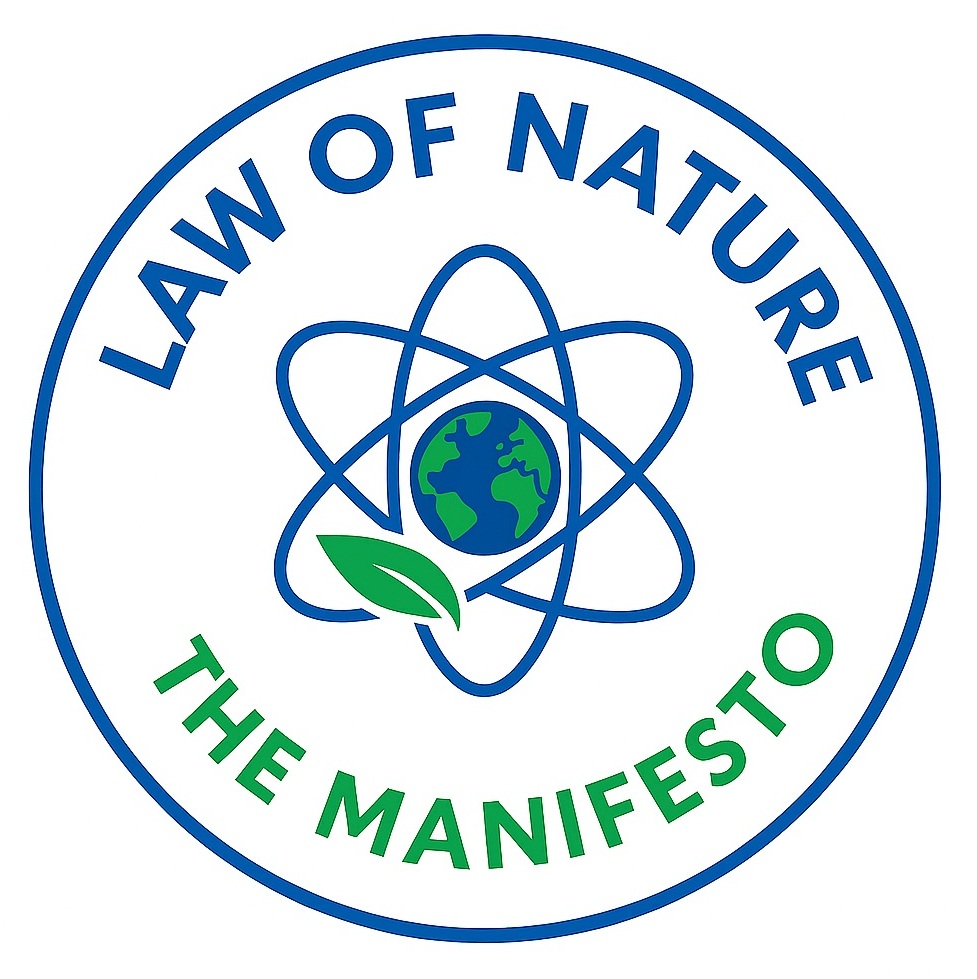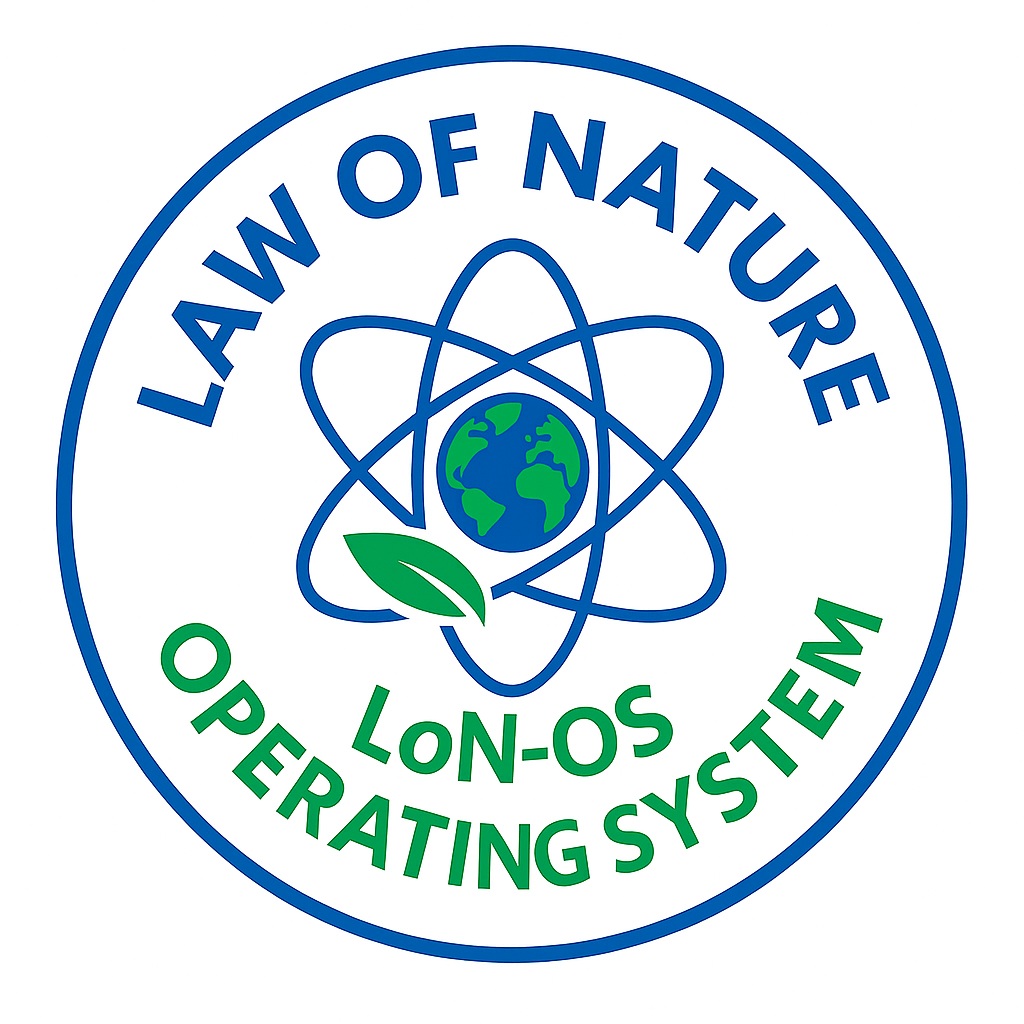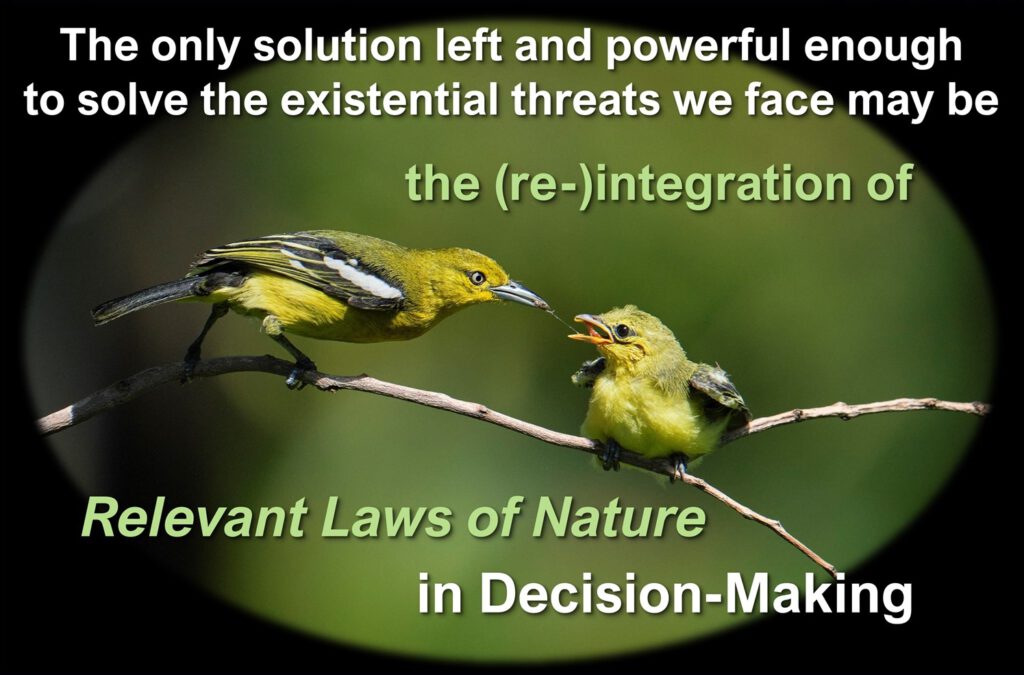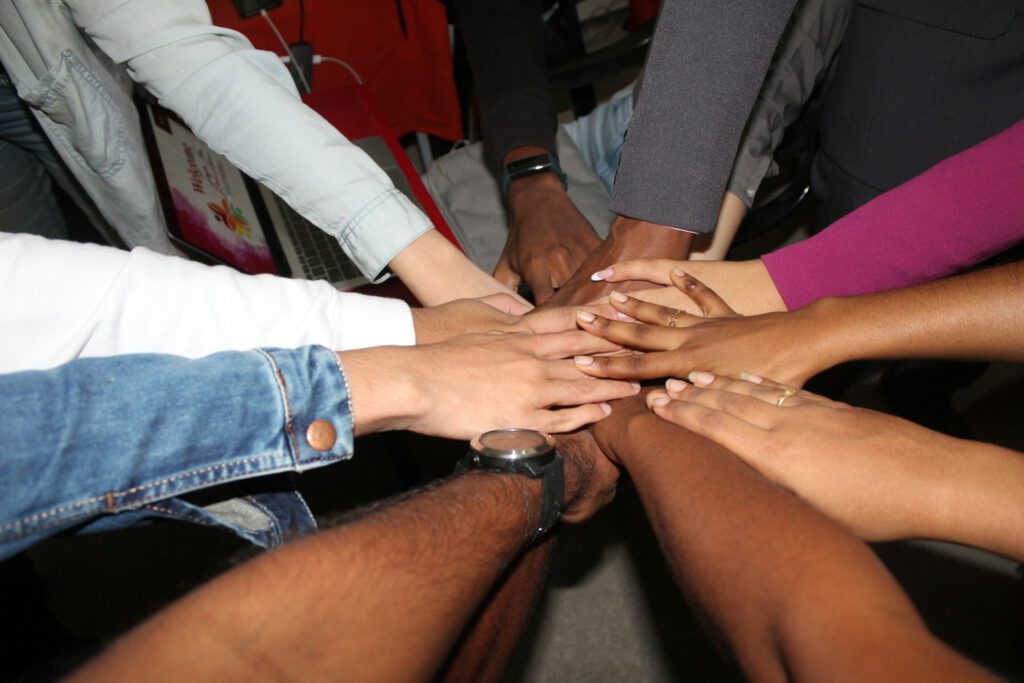The Law of Nature ManifestoTM
For Solving Complex Problems
A Lost Approach Made the Difference: Polymathy

By setting boundaries and requirements, our long-standing approaches have limited solution possibilities.
In contrast, the Polymath Approach goes beyond these limitations. By drawing on complex bodies of knowledge spanning multiple fields and subjects, it seeks the highest-impact solutions for the whole of a problem.
For more information, see Wikipedia and Manifesto Tutorial 3.4.3
Listening to what is REALLY NEEDED in TODAY’s WORLD to solve the growing problems we face
OVER
Applying what worked in a world gone by
Listening to what worked where our long-standing solution approaches failed us
OVER
Applying established models, best practices, frameworks, tools, trends, and long-standing ways of thinking
Taking on responsibility for the whole — at the system level
OVER
Partial solutions that leave too many obstacles, gaps and conflicts unsolved
Seeking the exact and verbal rules of the highest impact — at the highest system level
OVER
Seeking exact rules or rules for a part
Designing Executable Solution Frameworks of high-to-highest impact for the system level — FROM THE BEGINNING
OVER
Designing solutions for a part and assuming what works in a part can be scaled up in complex environments
Use What is Relevant — Ignore the Rest
This section applies to both the Manifesto and the Operating System


You or knowledgeable representatives of the groups involved and impacted select what is relevant. The rest can be ignored. — What matters:
1
Decision-makers and initiative owners are enabled to …
2
Solutions are designed from the start to be …
3
Knowledge representatives of the groups involved and impacted decide TOGETHER whether the specific solution is designed for meeting the criteria of point 2
4
It doesn’t matter whether points 1 to 3 are achieved through elements of this Manifesto+OS or through elements from elsewhere.
However, relevant Laws of Nature, root causes, Core Human Values and Essential Behaviours need to be addressed such that point 3 is met.
The Manifesto

Intervention Possibilities
of the Highest Impact at the Lowest Costs and Risks
1.
Let go of the thinking that created the growing problems. Keep what works well. What works well and fresh approaches complement each other for far-reaching effects.
Patterns of what communicates “too much of the same thinking that created the growing problems”
These 8 Manifesto intervention possibilities and 7 more in two extensions

2.
Listen to what delivered the needed results where our long-standing solution approaches failed us
3.
Intervene where the highest impact can be made at the lowest costs and risks™ AT THE SYSTEM LEVEL
After 2+ decades of failed solution attempts, large groups have learned to intuitively recognize when a new solution attempt or movement applies too much of the same thinking that created the growing problems. They respond with a lack of interest and support or opposition.

Common patterns of ‘the same thinking that created the problems’ include:

Hard Laws of Nature, typically available from physics, mathematics, chemistry, and biology cannot be overruled or ignored. Nature does not allow it. Yet, it happens day in and day out, resulting in huge damage, such as crippling bureaucracy, available solutions getting stuck in the system, resistance, and violent opposition. Several of the same laws provide practices to intervene where the highest impact can be made at the lowest costs and risks AT THE SYSTEM LEVELS. That’s without worrying about mathematics and across industries, fields, and challenges.
A simple introduction of the two Laws of Nature almost certain to occur in complex environments is available through the Manifesto Tutorials 1 & 2 of Intervention 4.
One word, derived from two Laws of Nature, is bound to provide the highest-impact solution at the lowest cost and risk for the crippling bureaucracy and overwhelming complexity. It prevents decision-makers and experts from unconsciously fueling bureaucracy and enables them to select practices that reduce bureaucracy, resistance, and opposition.
How this word can be applied is available via Tutorial 3.3: One Word to Make …
4.
Resolve the knowledge-experience-solution gap of how complex problems can be solved by TREATING IT AS A SINGLE GAP

With the growing problems being complex and the long-standing solution attempts having failed us for 2+ decades, it has become evident that the gap of how to solve complex problems must be resolved with a fresh approach.
When the Manifesto’s co-creators could not find any group, institute, or organisation addressing or taking on this matter at the required levels in the field, they took it on. Highest-impact knowledge from science and experiences with what delivered needed results, where our long-standing approaches failed us, led to an extension of this closing-the-gap intervention, short video tutorials and what delivered needed results.
5.
Get solution possibilities EARLY ON over the Tipping Point where they become executable, scalable, and durable at the SYSTEM LEVEL
Tutorial 3.4.2 of Intervention 4 includes a fresh approach to get over this Tipping Point EARLY ON and with little effort. When, despite the effort, it remains unclear how this Tipping Point can be crossed, foreseeable failure can be prevented by, for example:
It is clear how the system level can be achieved and this is part of the identified approach. Differences with the long-lasting but failed approach of ‘start small, scale up (and get stuck)’ are:
Scalability and system-level needs can be dropped when the problem to solve is within a small environment and the following criteria are met:
The early-on need can be dropped when the criteria for a small environment are met, and the analysts and solution designers are highly experienced in the cross-disciplinary knowledge and solution possibibilites of this Manifesto.
1 Value includes non-financial value such reducing (virtual) capacity bottlenecks like those of skill shortages, productivity improvement from motivated employees, and clients trusting vendors and institutions
6.
Ignite the PROBLEM-SOLVING thinking by asking THE SAME HARD-TO-IGNORE QUESTIONS which guide DECISION-MAKERS and EXPERTS to the HIGHEST-IMPACT SOLUTIONS
Examples
When decisions are to be made, the following questions can be asked:
The Manifesto’s collection of HARD-TO-IGNORE questions guiding to HIGHEST-IMPACT SOLUTIONS
7.
Verify decisions against relevant Laws of Nature, Core Human Values, Essential Behaviours and Value Cases
Decisions with far-reaching consequences are made day in and day out. Decision-making is the ‘place’ where the difference between fueling or solving the growing problems we face is made.
Manifesto Tutorials 1, 2, and 3.2 identify:
Tutorial 3.3 identifies how a single word, derived from two Laws of Nature, opens the door to get out of this trap and how this drastically reduces bureaucracy and complexity.

What created the gap: Observed patterns
Until the late 1990s, decision-making was based on a combination of numerical and pattern-based information1. Thereafter, it was believed that decisions should be predominantly based on hard information such as numbers, dollars, and euros, along with step-by-step proof. However, this approach only works up to the Tipping Point of complexity, and this critical limitation was overlooked. Beyond this Tipping Point, even mathematics cannot provide reliable outcomes.
Missing this limitation led to pattern-based information being overlooked and overruled by numerical and bureaucratic requirements, resulting in the LOSS OF A STRUCTURAL FOUNDATION FOR SOLVING COMPLEX PROBLEMS –More on this and the following is available through the What Delivered Needed Results, the Tutorials and in particular Tutorials 1, 2, 3.2 and 3.3.
1 Creating patterns is how our brains makes sense out of complex information.
Consequences of this gap: Observed patterns
Initially
Large groups learned to recognise when
The new approaches of agility and self-organisation failed for higher levels of complexity as executable guidance was missing (exceptions granted)
The situation escalated
Large groups withdrew their support from the establishment and backed other movements, even if it meant creating an additional dimension of problems, and moving us further away from solving the exponentially growing problems.
Solution needs
Over the past two decades, we have seen many attempts to solve this decision-making gap, such as demanding ethics, value-based decisions, regulations, and the like. Even if they are brought in line with the relevant Laws of Nature and further elements of this Manifesto, it remains hard to see how they can be made executable during decision-making processes and provide the value required. This led to these needs:
1. Value Cases need to complement business cases
2. A set of Core Human Values & Essential Behaviours is required:
If needed, they can be complemented with executable elements of ethics, regulations and the like.
Core Human Values, Essential Behaviours and a Value Case approach are available through the extension to this intervention.
8.
Consider one enterprise or system-wide project removing mountains of obstacles
Across industries, fields, and subjects, a common pattern emerged
High-to-highest-impact strategies, solutions, projects and the like are undermined and get stuck by the same obstacles, such as the obstacles of bureaucracy, complexity, and practices of a world gone by. These obstacles are usually outside the sphere of influence of these strategies, solutions and projects, and hiding below the surface. To create powerful strategies, make hidden solutions visible, and unleash their value potential, an enterprise or system-wide project aimed at removing these obstacles may be necessary.
Example: Simplification project –Good intention, but worsening the problem
What do we do when environments become too bureaucratic or complex? We start simplification projects in a few boxes. However, bureaucracy at the system level easily increases more than it is reduced within these boxes. This happens when the damage created from the changes outside the boxes exceeds the value created inside. In our connected world, it worsens when different groups chose different solutions and drift in different directions.
More on this and the simple solution are available in Tutorials 3.2 and 3.3, as well as in the tutorials of section 3.4 of the What Delivered Needed Results.
Manifesto Extension 1 — to Intervention 4:

Resolve the knowledge and experience gap in navigating toward the highest-impact solutions to complex problems
4.A
Learn practices for analysing complex problems and designing impactful solutions
When we understand where the highest damage is created, we have guidance on where the highest-impact can be made. Further patterns became:
With the growing problems we face, humanity can no longer afford to miss out on fundamental principles of science.
Yet, WHEN PROBLEMS TO BE SOLVED WERE COMPLEX, the Manifesto’s co-creators could not find anyone working with or responding to applying the following principles of science, neither in organisations nor in science itself. Typical responses were “doesn’t fit my discipline,” “what’s a Law of Nature?” or no response at all.
The following principles urgently need to be (re-)integrated into decision-making, research, strategy design, innovation processes, and much more:
Experience: A small number of such laws can have a huge problem-solving impact
Example of where these principles were applied: this Manifesto
The following practices emerged as foundations for re-creating trust. To make it happen, relevant practices may need to be part of a larger package designed to get over the Tipping Point where the package becomes executable, scalable, and durable at the system level (Intervention 5):
For Core Human Values and Essential Behaviours, see Manifesto Extention to Intervention 7
This is to enable people of various groups, fields and subjects to move into a common direction and act as a single entity
The guidance
4.B
From the Manifesto, the Laws of Nature, the What delivered needed results and the Tutorials, select what is relevant
Knowledgeable representatives of the groups involved and impacted decide TOGETHER what is relevant and will be used. The rest can be ignored.
Other solution elements you or the groups involved and impacted may have, as well as third-party guidance packages can be used, provided they:
4.C
Integrate relevant guidance into decision-making at all levels, problem analysis, solution design, innovation processes and Best Practices
4.D
Create complementary research and innovation processes
Based on:
Funded by:
For more information, see Manifesto’s Tutorial 3.4.4
Manifesto Extension 2 — to Intervention 7:

Core Human Values, Essential Behaviours, Value Cases & Hard-to-Ignore Questions
7.A Core Human Values
Health
This is the health of the people, organisation, environment and the planet1
As health requires biodiversity, it includes a healthy biodiversity
Safety
Includes climate and peace1
Basic Needs
Clean water and air, shelter, food, and energy1
Truth Seeking
What may be seen as the truth today can change over time. Establishing truth can be challenging. That’s why this value is truth seeking.
Freedom by being in harmony with each other
Everyone should be able to live freely. However, the freedom of one person ends where the freedom, health, or safety of another person begins.
1 Based on “Sustainocracy: The new democracy.” Jean-Paul Close. https://sustainocracy.blog/what-is-sustainocracy/
7.B Essential Behaviours
Acting With Adaptive IntegrityTM
We give our word (a promise, commitment, etc.) when we have sufficient confidence that we can keep our word. As soon as we know that we cannot keep our word, we inform all parties counting on us and clean up any mess that we caused in their lives. 1, 2
People, objects (organisations, products, services, etc.), and systems are IN or OUT of INTEGRITY.3
This is the practice of the Integrity Law
1 Integrity: Without it Nothing Works. Jensen, Michael C. Harvard Business School. Jesse Isidor Straus Professor of Business Administration, Emeritus. April 6, 2014. https://ssrn.com/abstract=1511274
2 First sentence adjusted to meet an executability need
3 Seminar. Jensen, Michael C. Erasmus University, Rotterdam. 2011.
Seeking the Truth
Being Authentic
Originality, worthiness, seeking the truth, kindness and compassion to see beyond ourselves and without neglect
Listening Authentically
Of course, this cannot mean listen to everybody and everything. Such approaches would quickly be in conflict with the Tipping Point and Capacity Bottleneck Laws of Nature. As such conflicts occur, a switch to other practices is required, like those most relevant to everybody, which brings us to the Core Human Values and Essential Behaviours provided here. A further practice is that of co-creation on equal terms, and with knowledgeable representatives of the groups involved and impacted.
Learning From Failure
In complex environments failure is guaranteed to happen as every situation can or will be different and the ‘unexpected unexpected’ keeps popping up. The following pattern surfaced: Learning from failure and an attitude of preventing the same failure from re-occuring reduces failure rates structurally.
Take Ownership
Taking ownership is about taking the initiative and communicating regularly with stakeholders to ensure that expectations are shared transparently
Personal responsibility and accountability
Within boundaries, individuals and teams are given the freedom and means to solve complex problems:
7.C Value Case Approach
Like Business Cases identify high-to-highest impact information in the form of money and numbers, Value Cases do the same with patterns. For more information, see the additional information at Manifesto Intervention 7 above.
Patterns are reliable practices because creating patterns is how our brains make sense of complex information. A benefit is that we do not have to go through endless discussions, for example, about agreeing on definitions. Everybody can have a somewhat different view. As long as we understand each other, decisions can be made.
With the numbers AND patterns at hand, hard-to-ignore Guiding Questions — such as those in the dropdown box below, and in the collection of Manifesto Intervention 6 — are responded to.
Example patterns:
When decisions are to be made
Does the decision improve or worsen the health of the people, organisation, environment, or planet?
When stress, burnout rates, or cost saving-pressures are high
When productive employees are laid off
When decisions are made
Where is the project to reduce the unnecessary bureaucracy and complexity to healthy levels by applying the Tipping Point and Capacity Bottleneck Laws of Nature (more in Tutorials 1, 2 to 3.3)?
On Adaptive Integrity
Is the person, group, organisation or system IN, or OUT of INTEGRITY?
Is the object (i.e. a product), solution, or service IN, or OUT of INTEGRITY?
On Attitude
Is the person’s attitude in line with relevant Core Human Values, Essential Behaviours, Value Cases approach, and Laws of Nature?
Is it based on
On Learning from Failure
Is the organisation’s culture one of learning from failure, or is it one hit by the same failures being repeated?